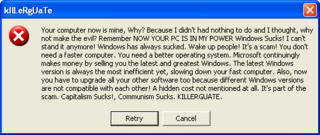BadTrans is a malicious Microsoft Windows computer worm distributed by e-mail. Because of a known vulnerability in older versions of Internet Explorer, some email programs, such as Microsoft's Outlook Express and Microsoft Outlook programs, may install and execute the worm as soon as the e-mail message is viewed.
Klez is a computer worm that propagates via e-mail. It first appeared in October 2001 and was originated in China. A number of variants of the worm exist.
SQL Slammer is a 2003 computer worm that caused a denial of service on some Internet hosts and dramatically slowed general Internet traffic. It also crashed routers around the world, causing even more slowdowns. It spread rapidly, infecting most of its 75,000 victims within 10 minutes.

This timeline of computer viruses and worms presents a chronological timeline of noteworthy computer viruses, computer worms, Trojan horses, similar malware, related research and events.

Blaster was a computer worm that spread on computers running operating systems Windows XP and Windows 2000 during August 2003.
Bagle was a mass-mailing computer worm affecting Microsoft Windows. The first strain, Bagle.A, did not propagate widely. A second variant, Bagle.B, was considerably more virulent.
Agobot, also frequently known as Gaobot, is a family of computer worms. Axel "Ago" Gembe, a German programmer also known for leaking Half-Life 2 a year before release, was responsible for writing the first version. The Agobot source code describes it as: “a modular IRC bot for Win32 / Linux”. Agobot was released under version 2 of the GNU General Public License. Agobot is a multi-threaded and mostly object oriented program written in C++ as well as a small amount of assembly. Agobot is an example of a Botnet that requires little or no programming knowledge to use.
Bolgimo is a Win32 computer worm, a self-replicating computer program similar to a computer virus, which propagates by attempting to exploit unpatched Windows computers vulnerable to the DCOM RPC Interface Buffer Overrun Vulnerability using TCP port 445 on a network. The worm was discovered on November 10, 2003, and targets Windows NT, 2000 and XP Operating Systems.
Zotob is a computer worm which exploits security vulnerabilities in Microsoft operating systems like Windows 2000, including the MS05-039 plug-and-play vulnerability. This worm has been known to spread on Microsoft-ds or TCP port 445.
The Nimda virus is a malicious file-infecting computer worm. It quickly spread, surpassing the economic damage caused by previous outbreaks such as Code Red.
William Genovese is a former greyhat hacker turned security professional, who goes by the alias illwill.
Brontok is a computer worm running on Microsoft Windows. It is able to disperse by e-mail. Variants include:
RavMonE, also known as RJump, is a Trojan that opens a backdoor on computers running Microsoft Windows. Once a computer is infected, the virus allows unauthorized users to gain access to the computer's contents. This poses a security risk for the infected machine's user, as the attacker can steal personal information, and use the computer as an access point into an internal network.

The Storm Worm is a phishing backdoor Trojan horse that affects computers using Microsoft operating systems, discovered on January 17, 2007. The worm is also known as:
Backdoor.Win32.IRCBot is a backdoor computer worm that is spread through MSN Messenger and Windows Live Messenger. Once installed on a PC, the worm copies itself into a Windows system folder, creates a new file displayed as "Windows Genuine Advantage Validation Notification" and becomes part of the computer's automatic startup. In addition, it attempts to send itself to all MSN contacts by offering an attachment named 'photos.zip'. Executing this file will install the worm onto the local PC. The Win32.IRCBot worm provides a backdoor server and allows a remote intruder to gain access and control over the computer via an Internet Relay Chat channel. This allows for confidential information to be transmitted to a hacker.
W32.Alcra. F is a computer worm that is spread by P2P file sharing networks. It is regarded as a low-risk virus, and is usually detected by a virus scan.
Koobface is a network worm that attacks Microsoft Windows, Mac OS X, and Linux platforms. This worm originally targeted users of networking websites like Facebook, Skype, Yahoo Messenger, and email websites such as GMail, Yahoo Mail, and AOL Mail. It also targets other networking websites, such as MySpace, Twitter, and it can infect other devices on the same local network. Technical support scammers also fraudulently claim to their intended victims that they have a Koobface infection on their computer by using fake popups and using built-in Windows programs.

Conficker, also known as Downup, Downadup and Kido, is a computer worm targeting the Microsoft Windows operating system that was first detected in November 2008. It uses flaws in Windows OS software and dictionary attacks on administrator passwords to propagate while forming a botnet, and has been unusually difficult to counter because of its combined use of many advanced malware techniques. The Conficker worm infected millions of computers including government, business and home computers in over 190 countries, making it the largest known computer worm infection since the 2003 SQL Slammer worm.

Gruel, also referred to by F-Secure as Fakerr, was a worm first surfacing in 2003 targeting Microsoft Windows platforms such as Windows 9x, Windows ME, Windows 2000 and Windows XP. It spread via email and file sharing networks.
Brambul is an SMB protocol computer worm that decrypts and automatically moves from one computer to its second computer.




